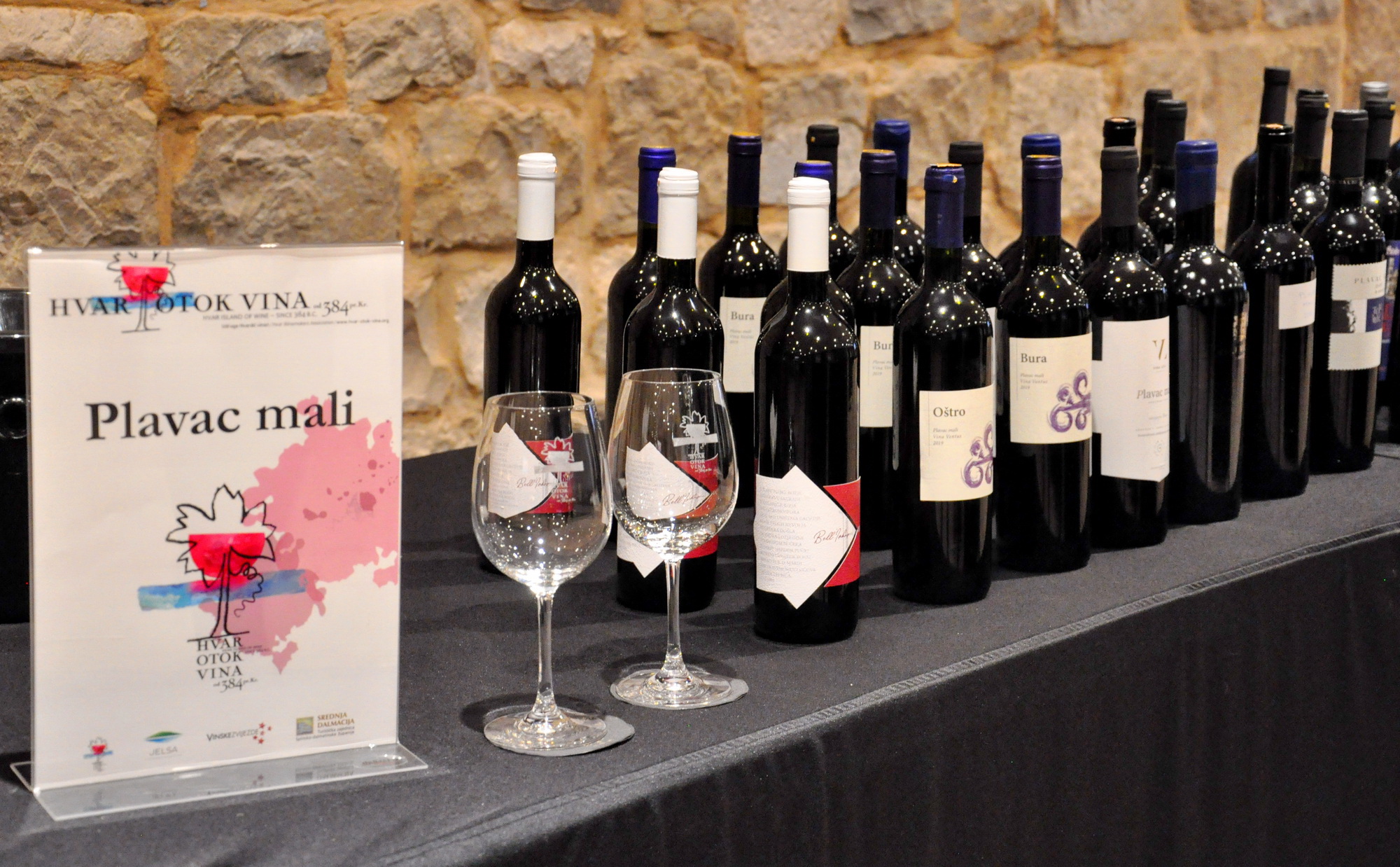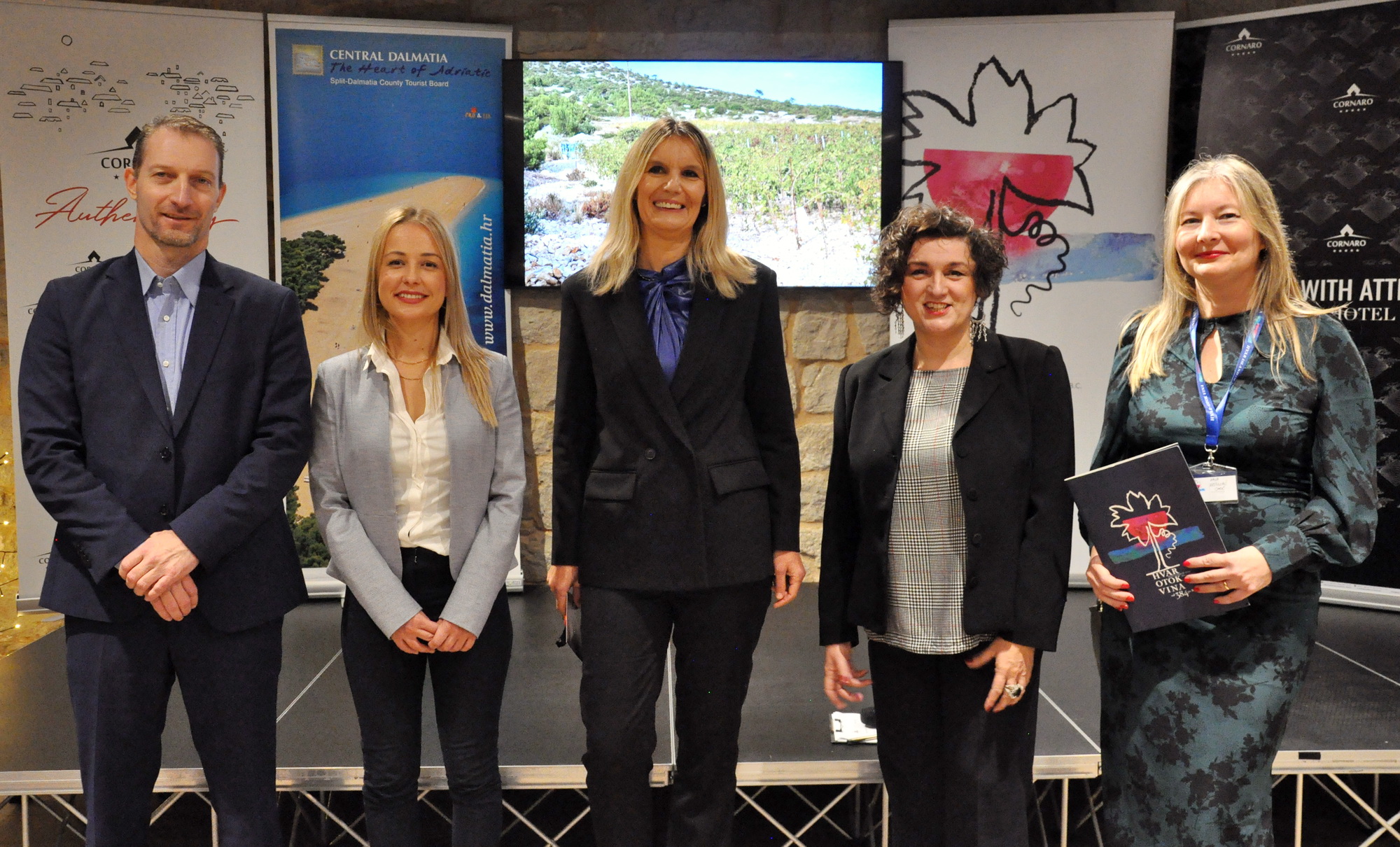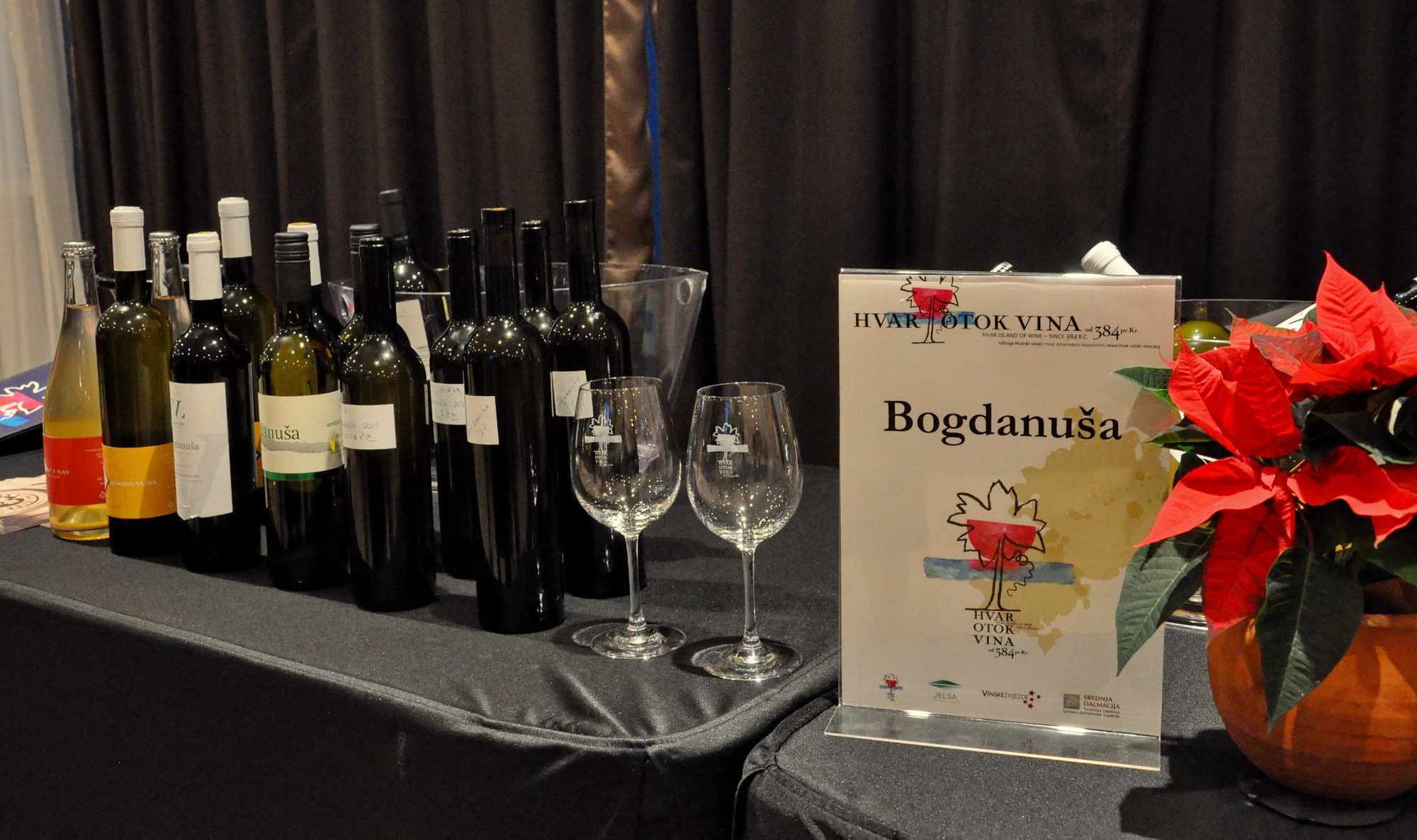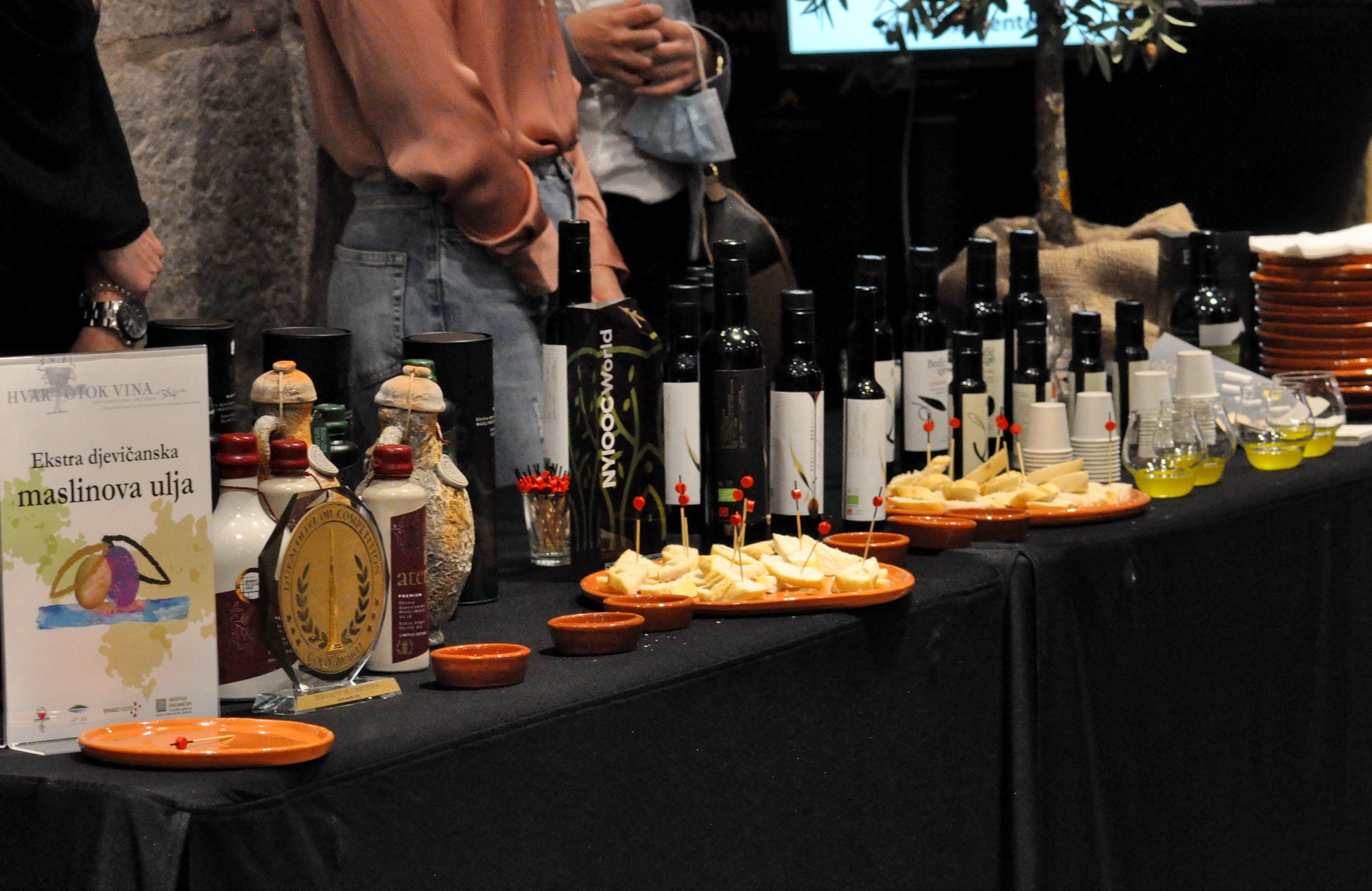Zadar Hinterland Drought Causing Desperation for Local Winemakers
August the 17th, 2022 - The ongoing Zadar hinterland drought is causing a feeling of insecurity and desperation among local winemakers of the area, of which there are a great many. The Zadar hinterland hasn't really seen any rain for around two months now, and it doesn't seem as if relief will come any time soon.
As Morski writes, it hasn't really rained in the Zadar hinterland for two months now, and the ongoing drought is severely harming both local farmers and winemakers, especially in Nadinsko polje, the most ecological vineyard in all of Croatia. Young vineyards with white varieties growing there suffered the most, and if there is no rain in the near future, the harvest will also be worse, and due to the lower yield, there could be problems in the wine cellars as well.
''There's a small amount only, it's pretty miserable. The rest [of what we have] is as it was a month ago, nothing is developing, it isn't getting any colour to it and it should already be turning yellowish so that you can see that it is ripening, but it isn't doing so because these leaves have been burned,'' pointed out winegrower and winemaker Tomislav Glavic.
Glavic planted a Marastina vineyard in the nutrient-rich mud here five years ago. After last year, when the crop was affected by extremely cold temperatures and adverse conditions, this year should have been very good.
''This is our autochthonous variety of Marastina which I had very high hopes for. Last year, everything was frozen, there weren't even any grapes to speak of. This year the harvest was meant to be excellent, it should have been one of the better vintages. Until a month ago, everything was fine,'' he said. The situation is the same in the nearby vineyard of Sime Skaulj in the Zadar hinterland. Both his varieties suffered.
''This is a young three-year-old plantation that should produce extremely high-quality wines, however, it will be difficult to get a quality wine from here now. There's been no photosynthesis, no ripening, no sugar in the grapes, even though these are varieties that achieve very high sugars, but this year that isn't going to happen,'' said Skaulj.
Droughts in the Zadar hinterland, scorching, damagingly high temperatures and storms this summer have all been a fatal combination for these young vineyards.
''We had days when the temperature was 45 and there hasn't been a single drop of rain here since June the 9th. Actually, we had about four tiny drops ten days ago, but that's neither here nor there,'' said Glavic.
''This vineyard needs about 30 litres per square meter. If 30 litres of water had fallen here back at the end of July, it would have been amazing. We don't need a lot of water here, but we don't have a lot of it either,'' explained Skaulj.
''The annual requirements of the vines in terms of precipitation are somewhere from 650 to 850 litres of rain water. From April the 1st to July the 30th, we had somewhere around 176 litres with a very unfavourable precipitation schedule. We've actually got a situation in which these bunches have been exposed to very harmful UV radiation,'' said Zvonimir Vlatkovic from the Croatian Ministry of Agriculture.
If there is no serious rainfall soon, even though the vines have deep roots and are more resistant to drought, even the older, well-established vines will feel it. The harvest from the young plantations could be below average, and the quality could also come into question.
There are about 1,330 hectares of vineyards in not only the Zadar hinterland but spanning the entire territory of Zadar County. All of them have been constantly exposed to extreme temperatures. The situation is better in those that have an irrigation system, although they're also struggling to maintain an average and high-quality crop this year. In recent years, Zadar's local winemakers have made a big step forward when it comes to quality. The market recognises and acknowledges them, and it would be much easier to maintain that level of quality if the plantations didn't depend solely on the whims of nature, which is often cruel.
The straw for not only the winemakers of the Zadar hinterland but for winemakers up and down the country could be EU funds. In the new programme period starting in 2023, the emphasis is, among other things, on irrigation systems, as reported by HRT.
For more, make sure to check out our dedicated lifestyle section.
Croatian Wine Region: A Brief Recap of Dalmatia
5 March 2022 - With its diverse climate and terrains, winemakers produce over 45,000 tons of Croatian annually, alongside an astounding variety of award-winning wines. In line with the Dalmatian Wine Festival taking place this week in Split (April 8-9, 2022), here’s a refresher on Croatian wine and winemaking in this region.
Croatian wine and viticulture
Did you know that almost 85% of Croatians drink wine? Perhaps it comes as no surprise considering viticulture has been present in the region for almost 4,000 years.
Today, the tradition of winemaking is still going strong. Croatia has over 300 wine producing regions, clustered into 4 main geographical areas - the Croatian Uplands, Slavonia/Croatia Danube, Istria/Kvarner and Dalmatia. The differing climates and terrains between the 4 regions produce more than 130 indigenous grape varietals and distinct styles of wine.
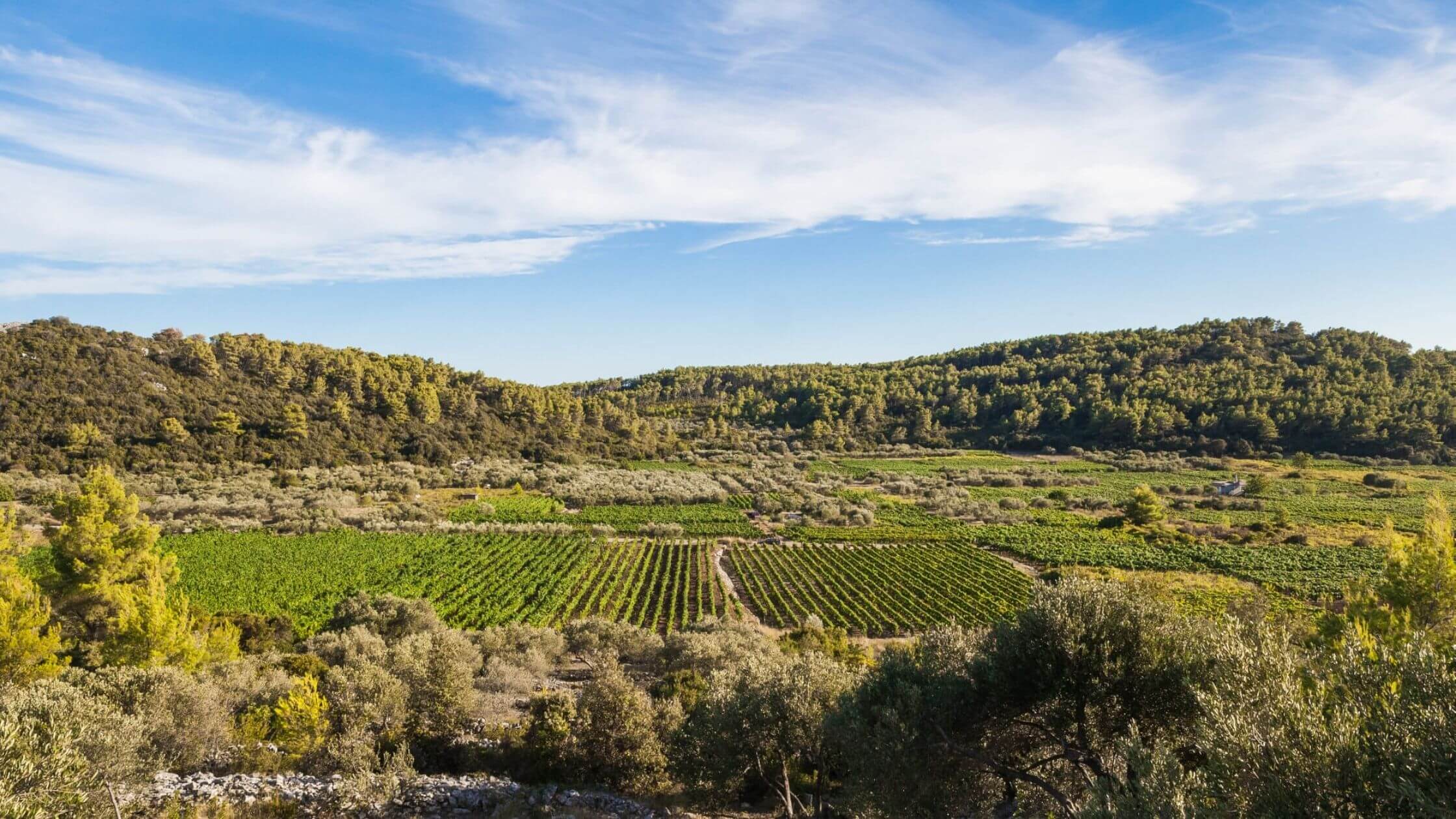
The vineyards of Korčula. (Image: Visit Korčula/Facebook screenshot)
Although the majority of wines produced are either white (67%) or red (32%), the wide variety of local grapes means that you’ll be able to find anything from bottles of dry, fruity white wines to luscious full-body reds that are a delightful addition to any meal.
To know more about different wines and wine regions around Croatia, be sure to read our series on Croatian wine regions.
Wine production in the Dalmatian region
As far back as the beginning of the 3rd century, works of Greek writer Athenaeus contained verses describing the high-quality wines produced on the Dalmatian islands of Vis, Hvar and Korčula.
The coastline is ideal for grape cultivation due to its hot summers (21–27 °C) and mild winters (6–11 °C) that do not typically fall below freezing. Dalmatia is also ranked as one of the sunniest places in Europe, receiving an average of 2,700 hours of sun per year.
These conditions make it ideal for grape production, resulting in the number of indigenous grape varieties in Dalmatia far exceeding that of the other 3 regions combined!
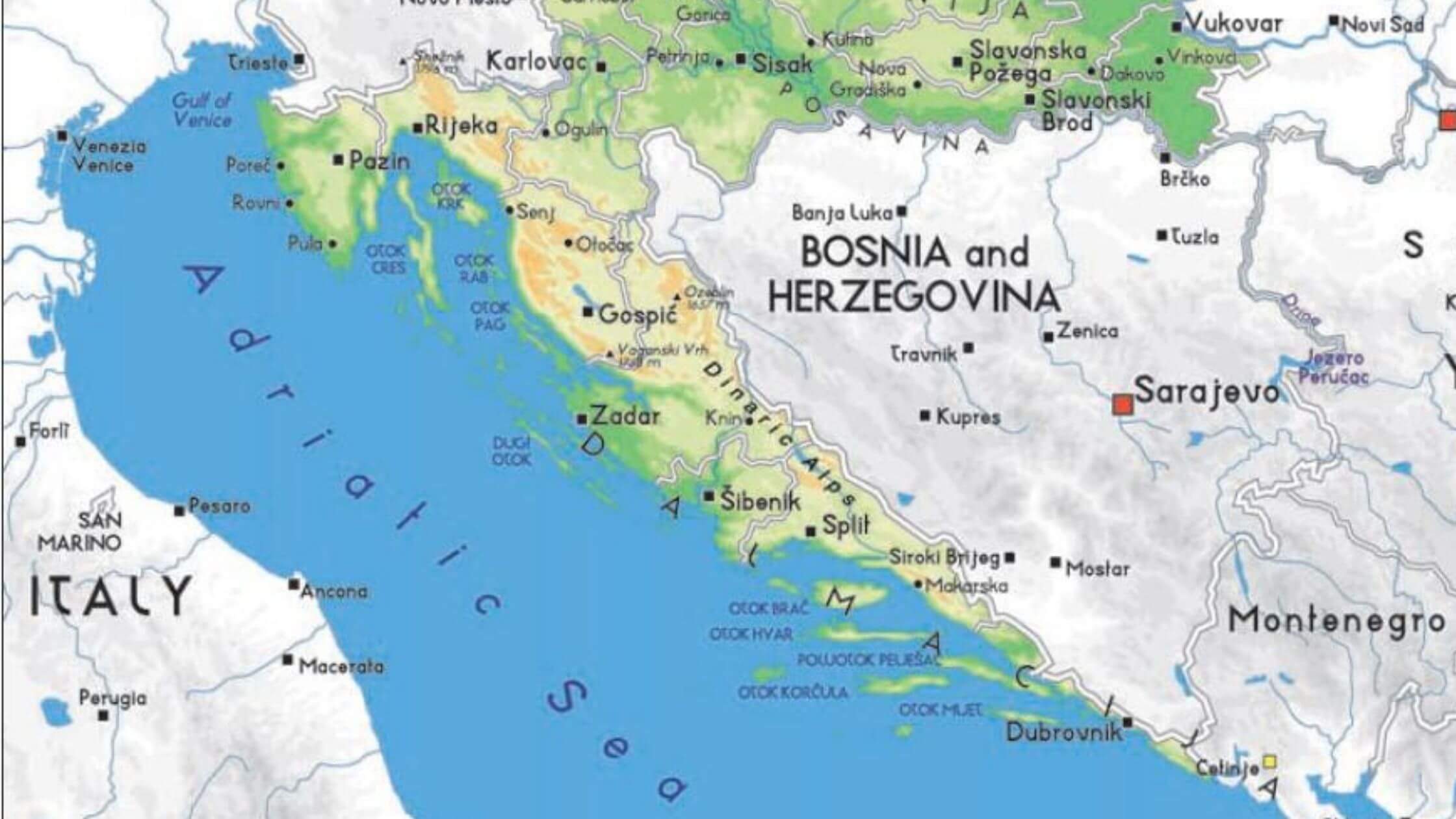
Dalmatia is only one of the 4 wine-producing regions of Croatia. (Image: Geography.name/Screenshot)
18 centuries later, the Dalmatian region continues to produce some of the most well-known, top-quality Croatian wine. As a testament to their growing global recognition, a Pošip from Komarna and Babić from Šibenik, were served to attendees of the 2022 Oscars in Hollywood.
Wondering what characterizes Pošip and Babić wines? Let’s delve into some of the more recognized white and red Dalmatian wines.
White wines of Dalmatia
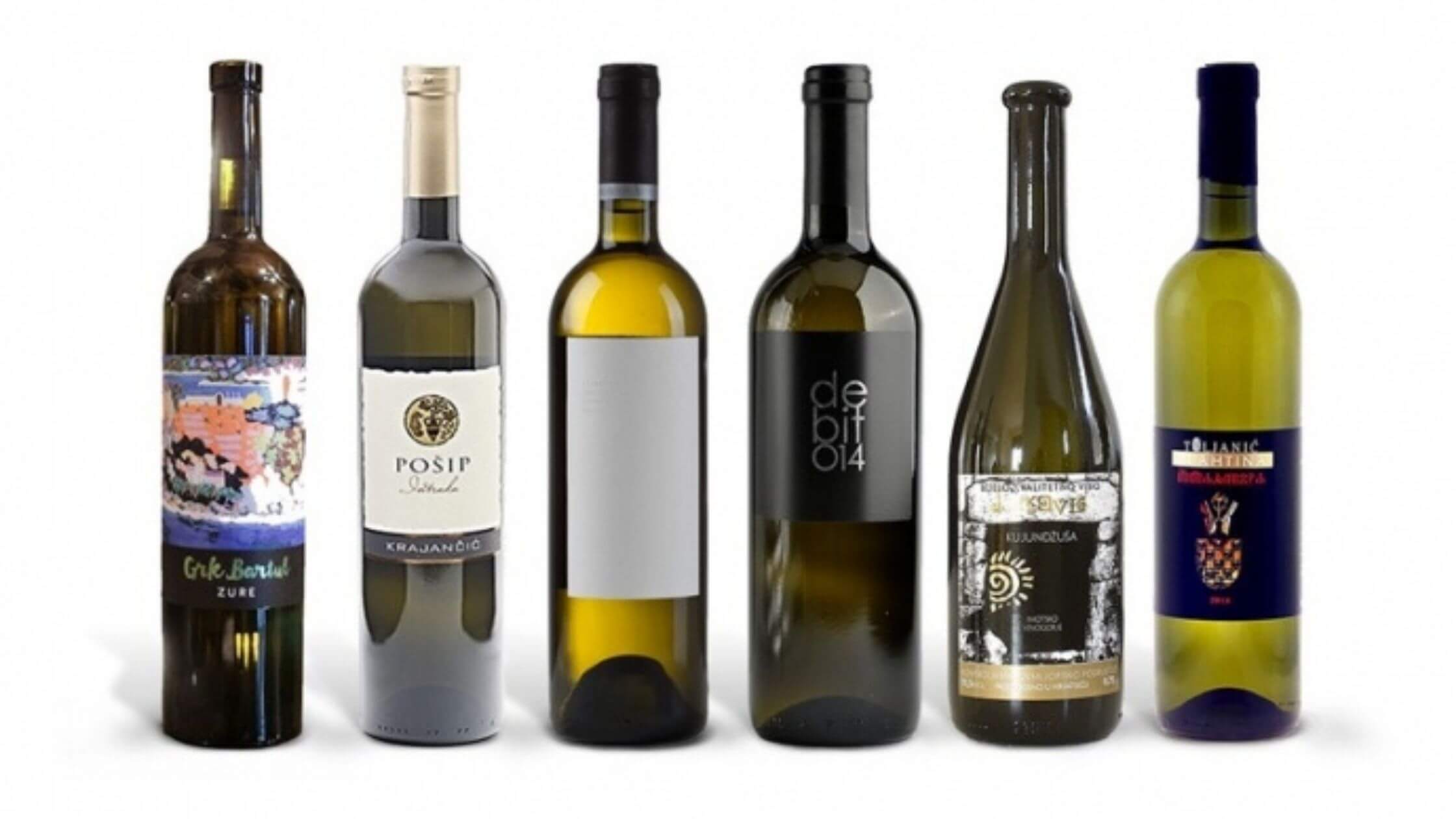
Croatian white wines are extremely refreshing to sip on during warm summer evenings. (Image: Total Croatia Wines/Screenshot)
Pošip – Pošip, with its greenish to deep honey gold hues and floral aroma, is a white-wine grape variety that was almost exclusively grown on the island Korčula and is indigenous to the village of Smokvica.
Pošip became the first white wine variety in Croatia with a protected geographical origin in 1967. In the last 20 years, Pošip cultivation has spread from Korčula to neighboring islands such as Hvar and Brač, as well as along the coast of Pelješac.
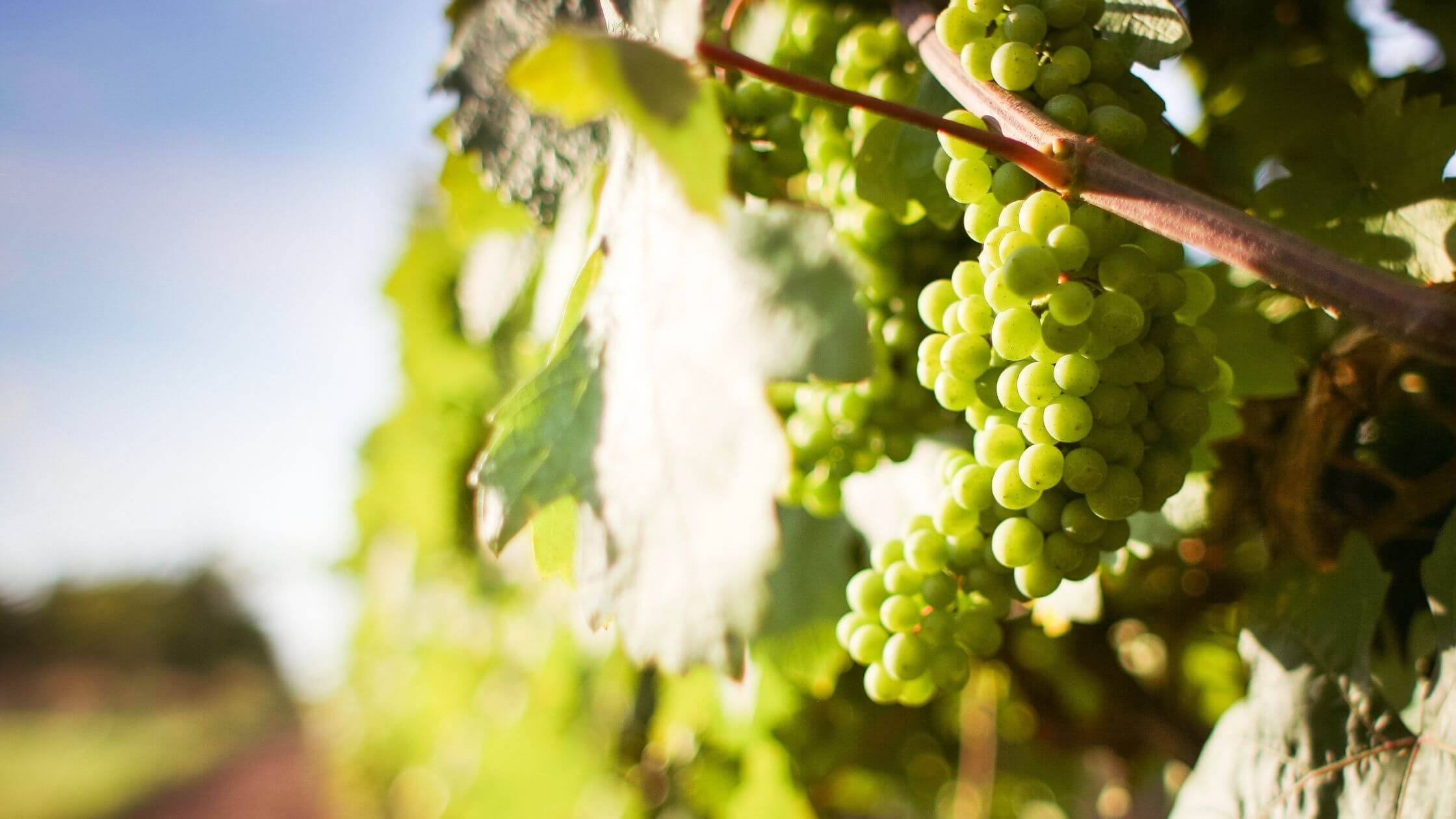
White-wine grapes growing on vines that are usually ready for harvest in the Fall. (Image: Pexels)
Pošip grapes are usually harvested in the first week of September, producing wines with a crisp fruity aroma, containing notes of apples, vanilla, citrus, and almonds. Overall, a balanced and elegant wine that pairs well with fish and shellfish, or for slow sipping on warm summer nights.
Grk – Grk is a golden-green, white-wine grape, indigenous to the sandy soils of Lumbarda on Korčula for over 2,000 years. While most wines are self-pollinators, Grk only produces female flowers and requires a male vine (often Plavac Mali) be planted nearby to enable pollination.
As a result, quantities of Grk produced are often quite small (1000 bottles or less per harvest), making this wine a rarity. The local lore is that wine producers used to only keep bottles of Grk for personal consumption, and to share with close family and friends.
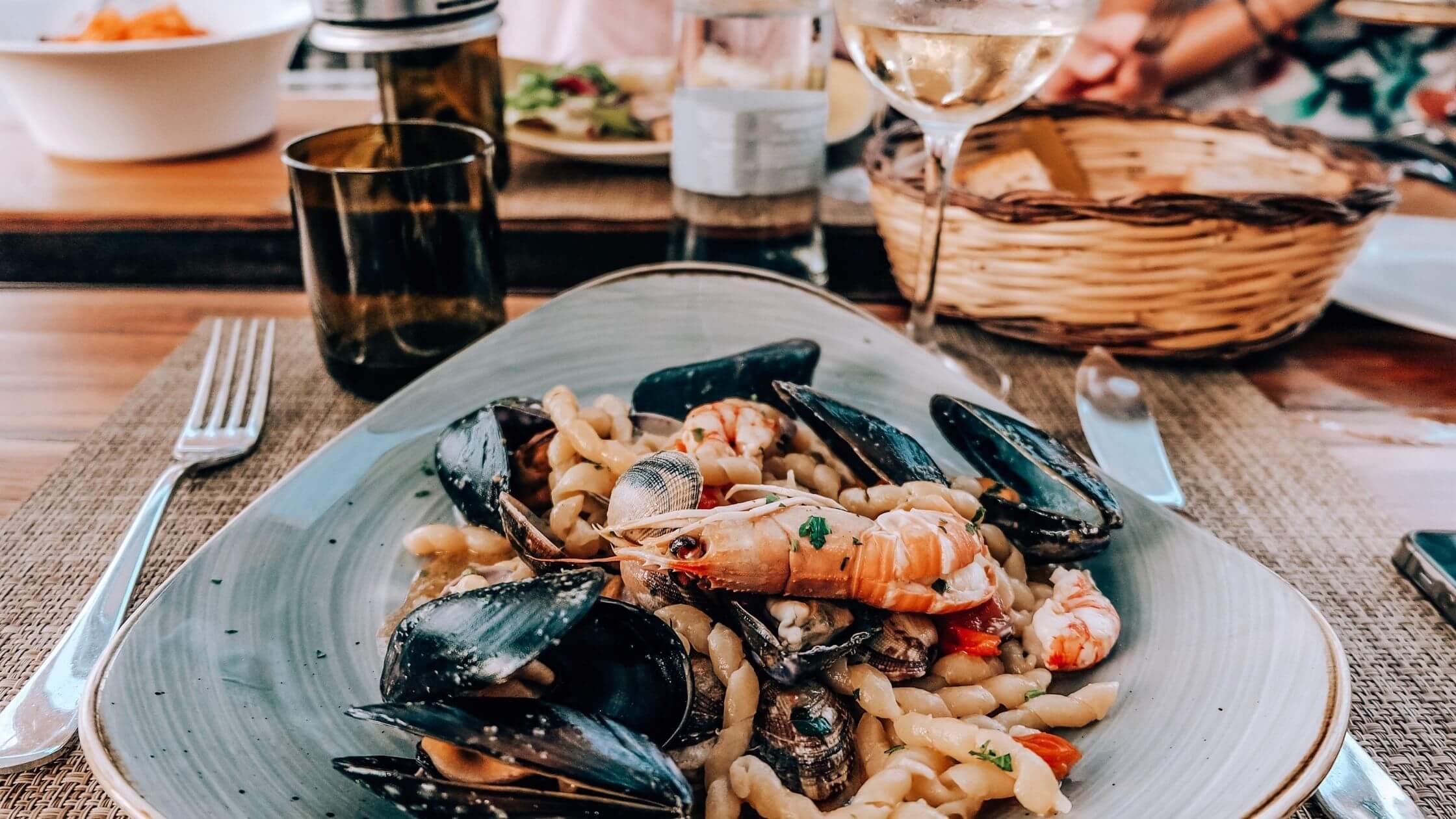
Pair a glass of Croatian wine with fresh seafood. (Image: Pexels)
If you manage to get your hands on a bottle, you’ll find that Grk is a dry white wine that can be adorned with notes of honey, pepper, pear, melon, herbs, and nuts. It pairs well with fish, seafood, chicken, and cold appetizers, but can also be served as an aperitif.
Debit – Another relatively obscure white wine of Dalmatia is Debit, produced from grapes of the same name. Debit is a straw yellow/gold, late-ripening grape variety grown along the northern and Croatian coast. Debit is indigenous to Croatia, but has some tenuous links to varieties in Italy and Turkey.
Why the name “Debit” though? Again, local folklore suggests that the wine’s name is said to date back to the Napoleonic Wars, where Croatian peasants lacked sufficient funds but ensured their safety by paying off French troops in local wine.

The small island of Korčula produces some of the most well-known white wines in Croatia. (Image: Visit Korčula/Facebook screenshot)
Debit is a fresh, sharp wine with herbal notes and a minerally profile, with some describing the wine to carry hints of limestone and oyster brine. With age, the aromas develop toasty notes like roasted nuts, candied lemons, and browned butter. This wine pairs well with mild seafood, or ingredients like ginger and coconut.
Red wines of Dalmatia

Croatia also produces delicious full-bodied red wines. (Image: Total Croatia Wines/Screenshot)
Babić – Babić grapes are characterized by their blue-red color, with the best quality wine (vrhunsko vino) coming from Primošten vineyards. These grapes are notoriously difficult to grow, with vines often needing a decade or more to reach their full potential, compared to other varieties that may reach that point after 6-7 years.
Upon maturity, vines tend to produce only 3-4 bunches of grapes each harvest due to the harsh soil conditions and intense sun. This leads to more concentrated flavors, imparting bold flavors to the wines.
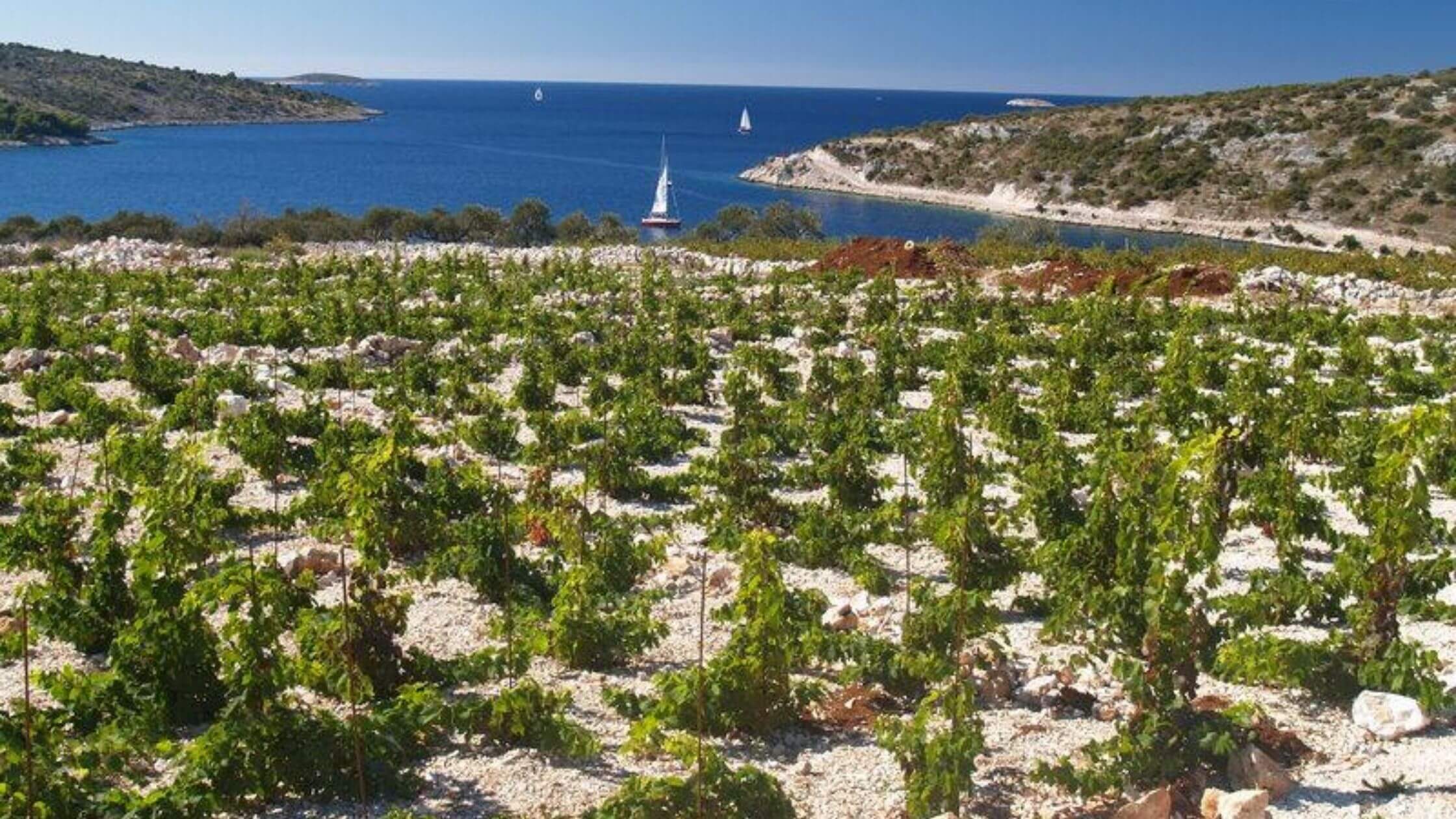
A Primošten vineyard overlooking the Adriatic. (Image: Njuškalo/Screenshot)
Babić wines are dark cherry red in appearance and full-bodied due to their firm tannins. The most common flavors in these wines are sour cherries, plums, and figs. This wine pairs especially well with hearty tomato-based dishes such as goulash or a rich ragu sauce. It also makes a delicious accompaniment to a hearty steak or pork tenderloin.
Plavac Mali – Plavac Mali or “small blue” in English, gets its name from the appearance of the grapes. It is also the most important and protected Croatian red wine variety, so much so that in 2021, experts from the wine industry dedicated a day to celebrate International Plavac Mali Day.
Like Babić, Plavac Mali has low grape yields which lead to concentrated, rich wines with deep burgundy colors. The “fiery” wine is typically dry, higher in both alcohol (12-17%) and tannins, making it slightly bitter, but with mild acidity. It is also full of ripe fruity flavor with notes of blackberry, cherry, smoke, and spice.

The Plavac Mali grape. (Image: Goran Zdunić/Vinopedia.hr)
This wine pairs well with aged cheese, red meat, and hearty dishes like oxtail stew. A bottle of Plavac Mali would not be out of place at a family BBQ, weddings, or the most luxurious Michelin-starred restaurants in Croatia.
Zinfandel – While Zinfandel is largely known internally as a Californian wine, it was confirmed by researchers in 2002 that its roots are proudly Croatian. Records from the 15th century reflect winemaking from Tribidrag grapes, the variety used to make Zinfandel, on the Dalmatian islands of Hvar and Vis.
Prior to Plavac Mali, Tribidrag grapes were the most abundant red-wine grape in Dalmatia partly due to its tendency to ripen earlier than other varieties. Unfortunately, in the late 19th century, Tribidrag grapes faced extinction due to disease and mildew. An initiative to revitalize Tribidrag production came about in 2001, elevating Zinfandel’s Croatian identity over the next decade.
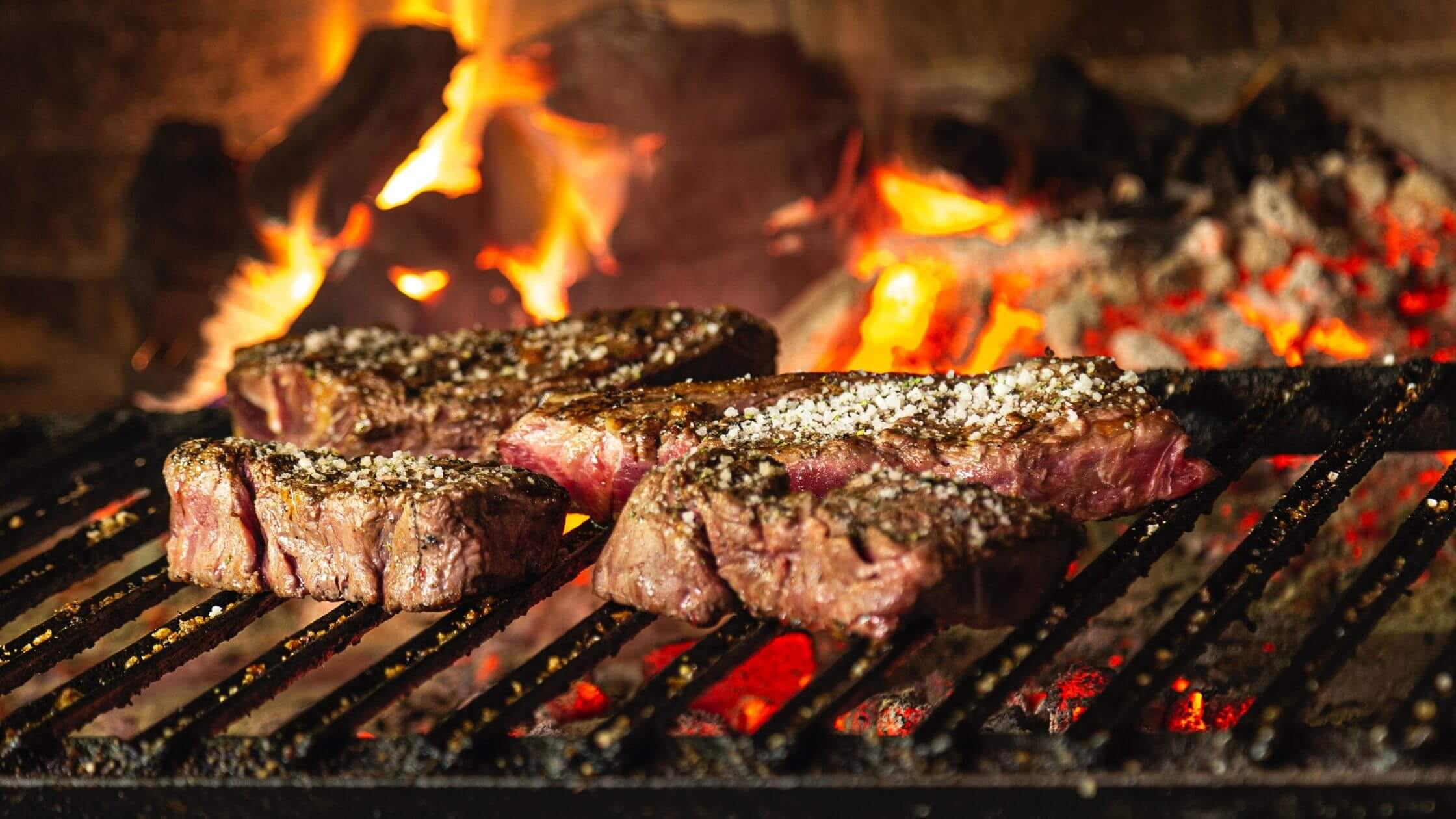
Croatian red wines tend to pair well with red meats and hearty tomato-based dishes. (Image: Pexels)
Zinfandel wine is a luscious red, with lower tannins than Plavac Mali. It usually carries notes of berries and spices, best paired with cured meats, red meats, and oily fish dishes like tuna.
Croatian wine and grapes are among the best in the world, and you can find more information about them in Total Croatia’s Guide to Croatian Wine HERE.
For more on lifestyle, follow TCN's dedicated page.
The Best of Hvar: 1st Business Meeting of Hvar Winemakers Was Held in Split
December 7, 2021 - The first business presentation and tasting of representative Hvar wines was held at the Cornaro Hotel in Split, called '' The Best of Hvar '', a collaboration between the Hvar Winemakers Association, the Wine Stars Evaluation Project, and the Jelsa Tourist Board.
On Friday, December 3, 2021, at 4 pm at the Cornaro Hotel in Split, the Hvar Winemakers Association organized the first business presentation and tasting of Hvar wines for representatives of the HORECA sector called The Best of Hvar. This event is designed as a continuation of good cooperation between the Hvar Winemakers Association and the Wine Star Evaluation Project which, with the support of the Jelsa Tourist Board, has been organizing a large island wine evaluation for the third year in a row. Every year the wines are getting better, and this is shown by the ratings that we monitor from year to year.
(Photo: Julio Frangen)
At the Split presentation, Bell'Iakov, Vina Carić, Hvar Hills, Vina Leše presented their young wines and new vintages "en primeur" according to the evaluation categories of the 3rd Jelsa Summer Wine Tasting by Vinske zvijezde - bogdanuše, other white wines, plavci - Luviji, Pavičić vina, Vina Svirče, Vina Tomić, Vina Ventus, Podrum Vujnović and Zlatan Otok. The winning wines of this year's evaluation were at a special exhibition place: Bogdanjuša Carić 2020, Pošip Tomić 2020, Hvar Hills Plavac mali Pharos Maxvmus 2013. The wines were accompanied by excellent Hvar extra virgin olive oils, awarded at domestic and international evaluations: Božić Uje, OPG Eva Curin, and OPG Magdalena Plenković oils of Athens.
From left to right: Joško Stella, director of the Split-Dalmatia County Tourist Board; Marija Marjan, director of the Jelsa Tourist Board; Ivana Klarić, director of Cornaro hotel; Marija Vukelić, Wine Star project manager; and Ivana Krstulović Carić, president of the Hvar Winemakers Association. (Photo: Julio Frangen)
The winemakers and business representatives were greeted by the director of Cornaro, the host hotel, Mrs. Ivana Klarić, emphasizing the satisfaction that a special event for Hvar's top winemakers is taking place in the top hotel. Mr. Joško Stella, director of the Split-Dalmatia County Tourist Board, praised the initiative, reminded of previous collaborations with the Hvar Winemakers Association, including an important presentation in Rome, and expressed the wish that such events continue. The director of the Jelsa Tourist Board, Marija Marjan, presented two significant Jelsa projects involving winemakers, oil producers, and family farms - "Wine, Olive and heritage festival" and announced the framework program of the jubilee 70th Jelsa Wine Festival, which is planned for last week in August 2022, Ivana Krstulović Carić, president of the Hvar Winemakers Association, reminded that the association has been operating successfully since 2010: "When we first met, we realized that the branding of island wines is extremely important, The island of wine, from 384 BC. Kr. In conclusion, Marija Vukelić, Wine Star project manager, praised the better ratings of Hvar wines, which give winemakers better visibility and placement in our and foreign markets.
(Photo: Julio Frangen)
Representatives of the caterers were able to taste for the first time at the first joint exhibition place young bogdanuša, wines of the original white variety of the island of Hvar. In the second exhibition place were other white wines of the island of the varieties prč and pošip, and cuvée of white wines, and in a special place were plavci, new vintages on the market and some already existing and renowned. Three categories and three exhibition places gave an insight into the community of winemakers and the top quality of wine from the whole island. Winemakers and guests at The Best of Hvar event were satisfied with the way of presentation, expressing a desire to organize the Zagreb "En primeura Hvar wines".
The wines were accompanied by excellent Hvar extra virgin olive oils, awarded at domestic and international evaluations. (Photo: Julio Frangen)
The Best of Hvar 2021 is the first business event of winemakers on the island of Hvar, popular "B2B" - business to business, which provides caterers with the opportunity to (early) assess the quality of new harvests, purchase (larger quantities) in advance for next season, on favorable terms - but also a reminder of existing harvests and Hvar wines that can be found on the holiday table and under the Christmas tree.
Croatian wines and grapes are among the best in the world, and you can find more information about them in Total Croatia’s Guide to Croatian Wine HERE.
For more on lifestyle, follow TCN's dedicated page.
Dalmatian Wine Icons: Taste the Best Dalmatian Wines
October 10, 2021 - Dalmatian Wine Icons is a prestigious wine event where Dalmatian winemakers present exclusively their best wines. It is a one-day promenade tasting that, due to its limited duration, winemakers from all parts of Dalmatia bring only one or a maximum of two labels, the ones they are most proud of.
Dalmatian Wine Icons is a prestigious wine event where Dalmatian winemakers present exclusively their best wines. It is a one-day promenade tasting that, due to its limited duration, winemakers from all parts of Dalmatia bring only one or a maximum of two labels, the ones they are most proud of, reports Turističke Priče.

Photo: Dalmatian Wine Icons
By presenting only special wines, the so-called cellar flagships, winemakers want to draw the attention of the public and the media to the exceptional concentration of quality that is more than evident in Dalmatia in recent years, and then to varietal and stylistic diversity and wine authenticity.
Namely, in Croatia, no region has the varietal and stylistic richness of Dalmatia, because the number of indigenous varieties in Dalmatia exceeds the total number of indigenous varieties of all other regions together, and confirmation of the highest quality of Dalmatian wines comes from renowned international competitions such as British Decanter. more of the brightest medals than any other region from this part of Europe.
Therefore, the manifestation of the Dalmatian wine icon is an exciting event of an exclusive character where visitors are given the opportunity to taste in one place the most important wines of Dalmatia, which dissolve them and which the wine authors tell them personally.
Promenade tasting will be held on October 23 at the area restaurants Campus of the University of Split, and the event will be opened from 12 to 19 h.
The day before the promenade tasting, on October 22, wine workshops will be held in the same space, led by renowned lecturers - Branimir Vukšić, Manuela Plohl, Kruno Filipović, Monika Prović, and Saša Špiranec.
![]()
Photo: Dalmatian Wine Icons
Workshop program
Friday, 10/22/2021
- 14: 00h Dalmatian rosé - Dalmatia is Croatian Provence; Branimir Vuksic
- 15:30 Aged white wines of Dalmatia of collector's value; Monika Prović
- 17: 00h Small varieties with great potential - indigenous varieties with the authentic stamp of Dalmatia; Kruno Filipović
- 18:30 Plavac, babić and tribidrag / crljenak - three black locomotives; Saša Špiranec
Saturday, 10/23/2021
- 14: 00h Decanter laureates - wine tasting that won gold and platinum medals at the last DWWA competition; Manuela Plohl
The complete organization and protocols are harmonized with sanitary and epidemiological standards, to make visitors feel safe.
Croatian wines and grapes are among the best in the world, and you can find more information about them in Total Croatia’s Guide to Croatian Wine HERE.
For more on lifestyle, follow TCN's dedicated page.
Six of the Best! Croatian Protected Produce On Sale in China
September 18, 2020 – Six items of Croatian protected produce are among the 100 European items to go on sale in China
Six items of Croatian protected produce are among the 100 European items to go on sale in China. In a reciprocal deal, 100 Chinese products will also be recognised and recommended on the European market.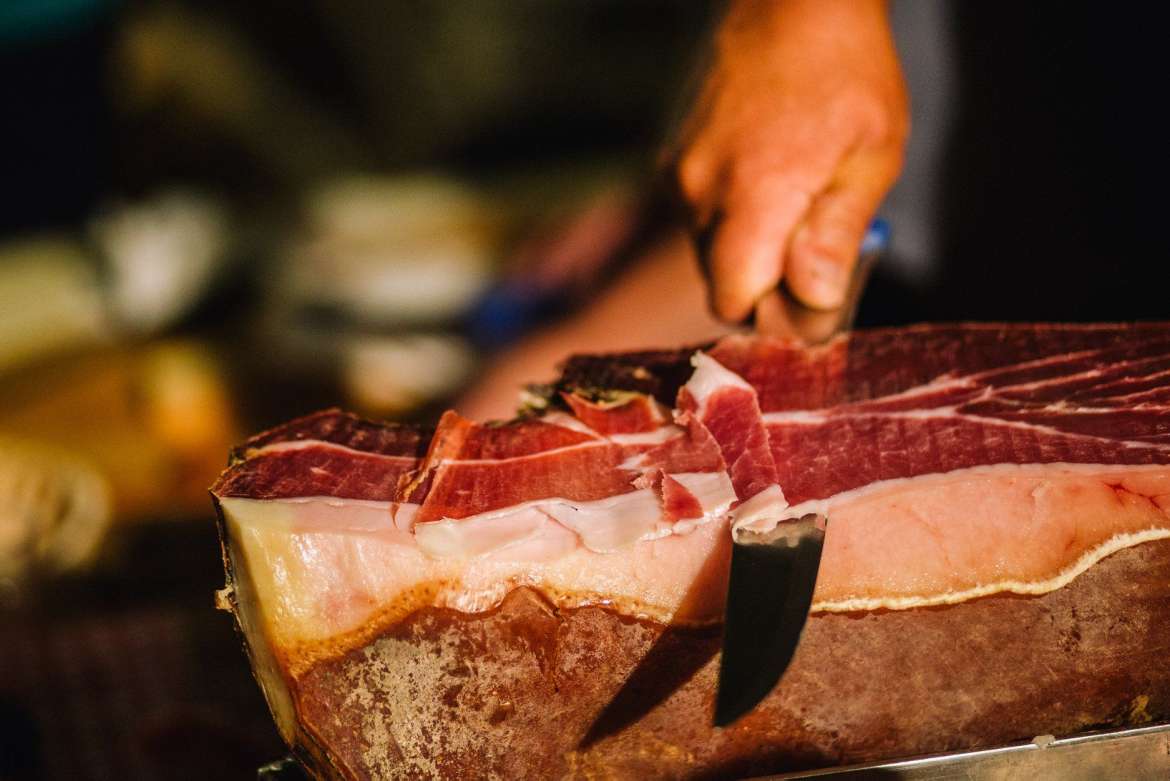 Dalmatian prosciutto © TZ Vrgorac
Dalmatian prosciutto © TZ Vrgorac
Baranja kulen, Dalmatian prosciutto, Drniš prosciutto, Lika potatoes, Dingač wine and Neretva mandarins are the premium six Croatian protected produce chosen to be among the European 100. All of the Croatian protected produce is already recognised at a national and at an EU-level and designated its status based on its unique place of origin.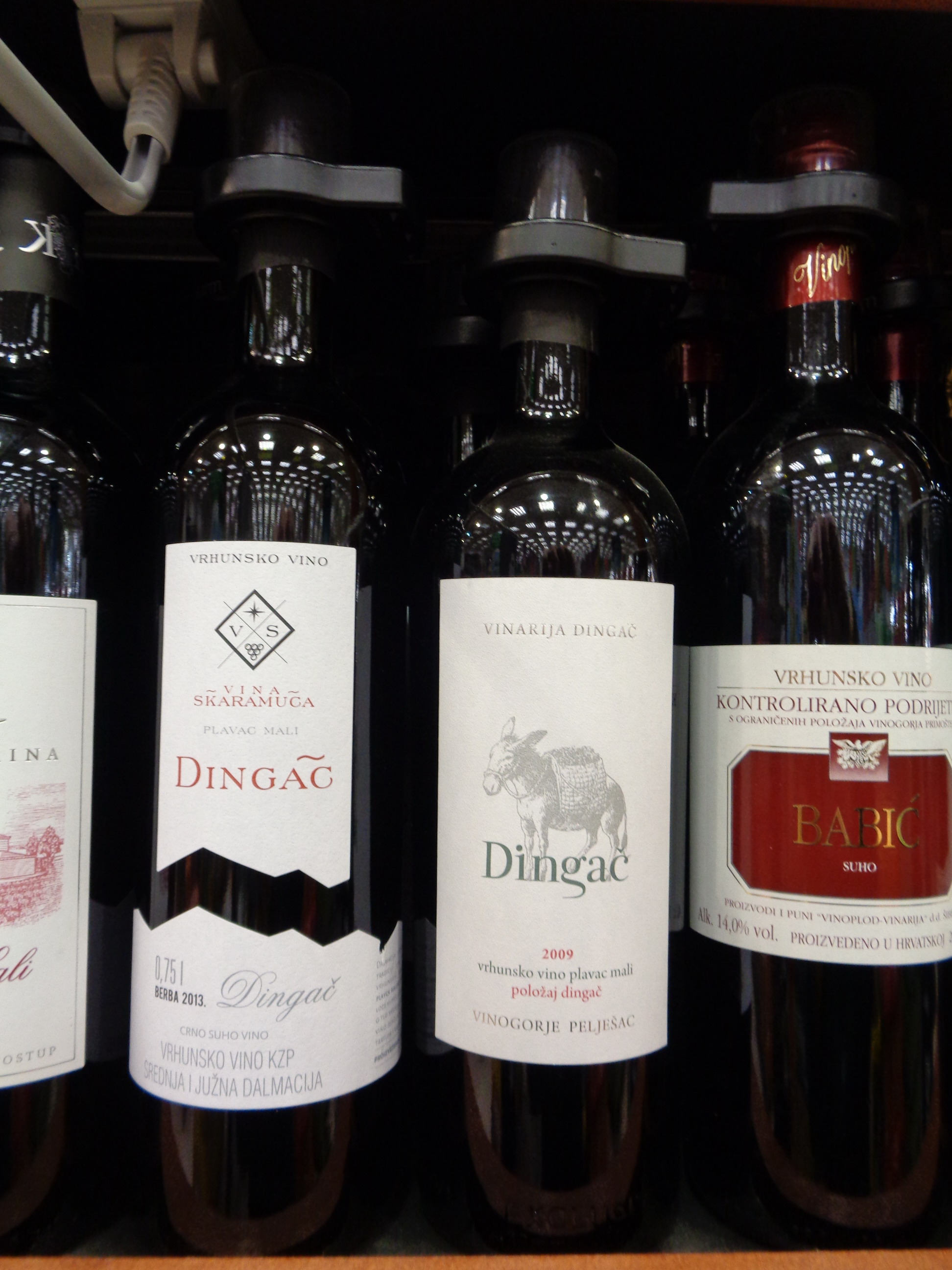 Dingač wine © Silverije
Dingač wine © Silverije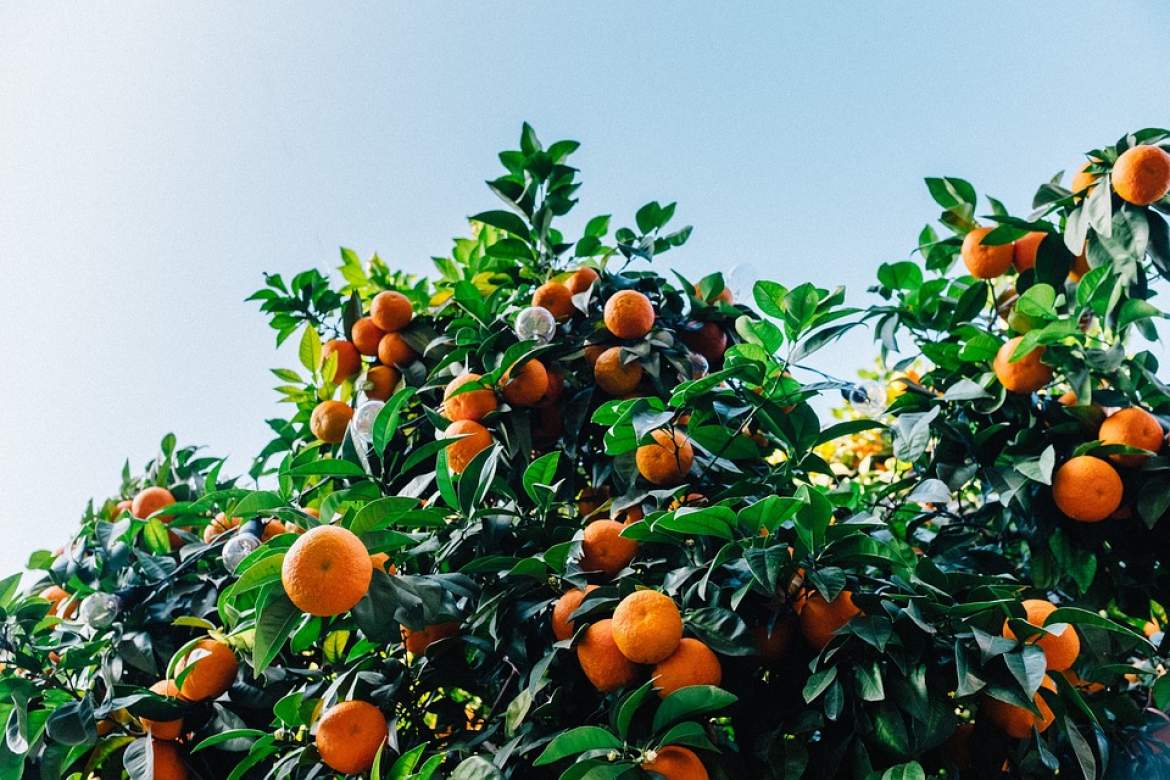 Neretva Mandarins
Neretva Mandarins
The European products will be specially marked and receive special privileges when they go on sale in China. Alongside the Croatian protected produce, other items on the European list are French champagne, Greek feta cheese, Italian Parma prosciutto, Italian mozzarella, Irish whiskey and Portuguese port. On the Chinese list of products are distinct varieties of rice, bean and vegetable products, some of which will already be popular with Europeans who eat or cook Chinese cuisine.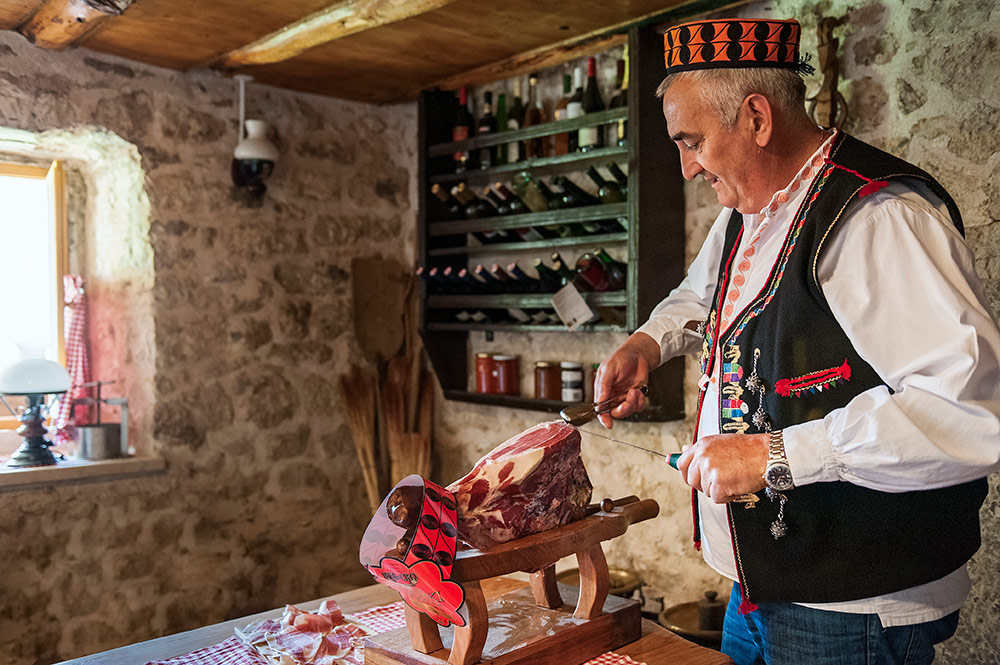 Drniš prosciutto © Tourist Board of Drniš
Drniš prosciutto © Tourist Board of Drniš
The full list of Croatian produce protected at an EU-level currently includes Istrian olive oil, Dalmatian prosciutto, Pag cheese, Lika lamb, Poljički Soparnik, Zagorje turkey, Korčula olive oil, Istrian prosciutto, Sour cabbage from Ogulin, Neretva mandarins, Slavonian honey, Drniš prosciutto, Cres olive oil, Pag salt, Baranja kulen, Bjelovarski kvargl, Varaždin cabbage, Pag lamb, Šolta olive oil, Meso 'z tiblice, Zagorje mlinci, Krk prosciutto, Lika potatoes, Slavonian kulen, Krk olive oil.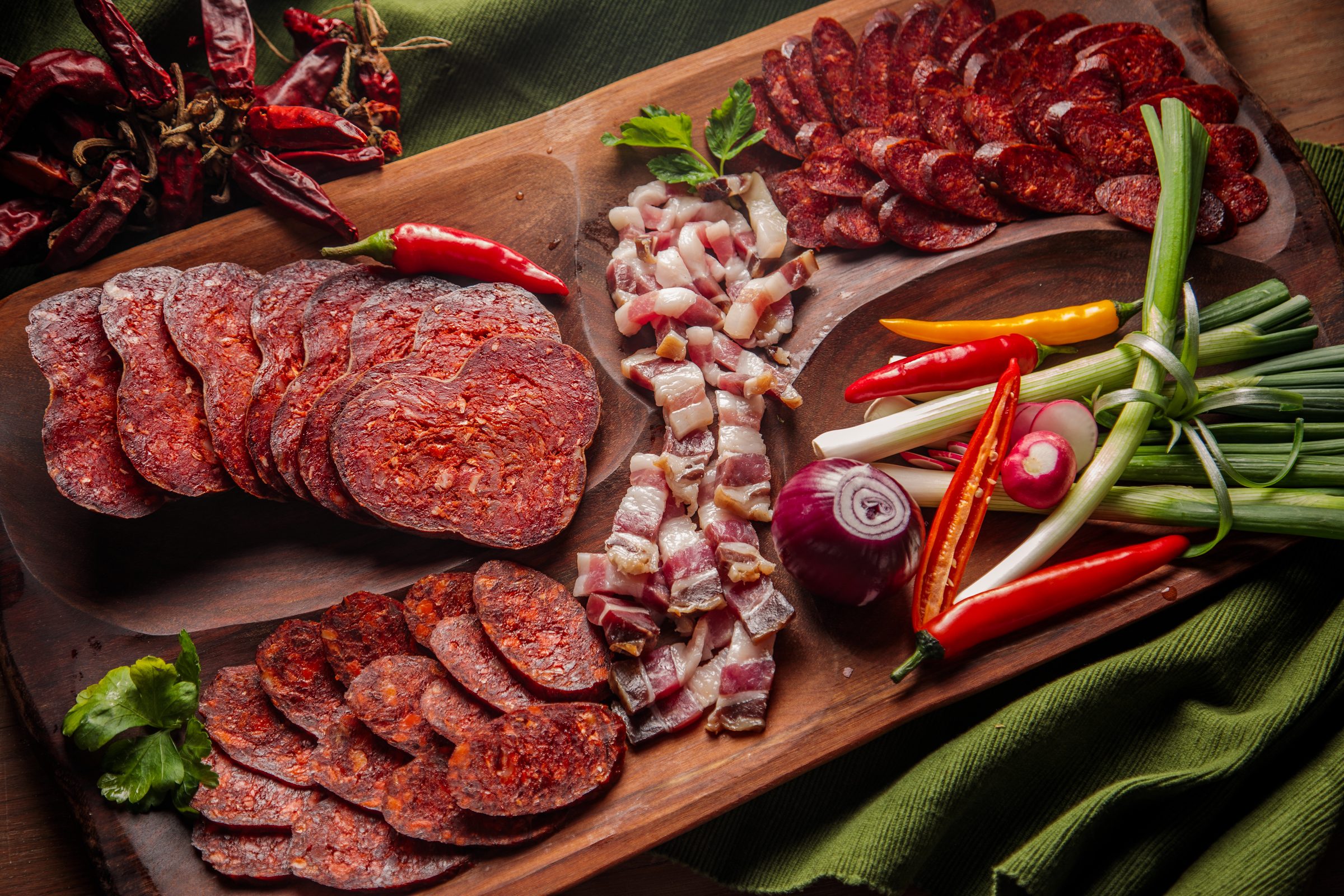 Baranja kulen, featured within a traditional Slavonian platter © Romulić & Stojčić
Baranja kulen, featured within a traditional Slavonian platter © Romulić & Stojčić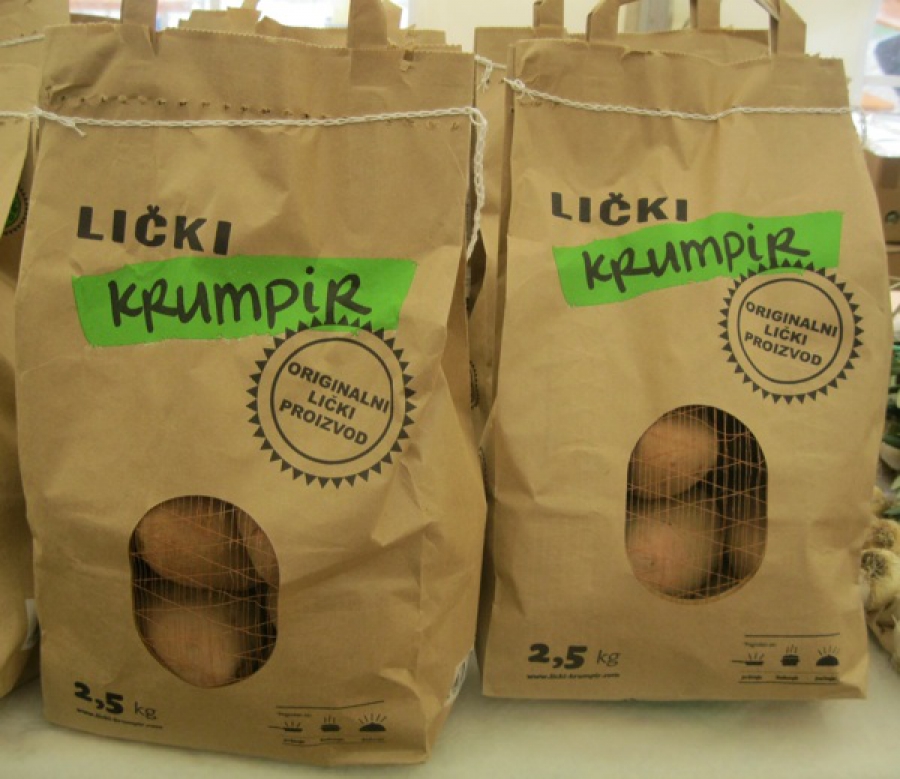 Lika Potatoes
Lika Potatoes
For the latest travel info, bookmark our main travel info article, which is updated daily.
Read the Croatian Travel Update in your language - now available in 24 languages
Dalmatian Wine Presented in Switzerland as Part of Croatian EU Presidency
As Morski writes on the 24th of February, 2020, the presentation of Dalmatian wine in Switzerland from the 25th to the 26th of February, 2020 will see the participation of the Hvar Winemakers Association and the Wine Association of Dalmatia with the co-financing of the Tourist Board of the Municipality of Jelsa and the Municipality of Jelsa.
The presentations of Dalmatian wine in Switzerland are organised on the occasion of the Croatian Presidency of the EU Council in cooperation with the Permanent Mission of the Republic of Croatia to the United Nations Office in Geneva and the Croatian Embassy in Bern. In addition to the presentations of Dalmatian wine, the typical dishes of the island of Hvar will also be prepared and presented by chefs Kristo Barbic and Pavo Kordic, as will products from Hvar such as olive oil, lavender, etc.
Dalmatia is a true treasure trove when it comes to the sheer biodiversity of the wine world. Travelling from north to south, it's easy to find new, different varieties. The most famous and economically most important variety of Dalmatian wine is the internationally adored Plavac mali.
''With these presentations, we want to showcase the richness of varieties that Croatia has: we've gathered together twelve Dalmatian wineries, and as many as ten Dalmatian varieties will be tasted. We designed the tour in cooperation with the Tourist Board of the Municipality of Jelsa to present the environment in which our wines are made, because the story of Dalmatian wine is not only the taste and the aroma of wine, but also a number of cultural and anthropological elements together.
As an example, we will show what the island of Hvar has to offer, through its UNESCO heritage, products from the island, such as lavender, olive oil, typical cakes and even chocolates that capture the flavours of Dalmatia and the Mediterranean. And of course, with the sounds of the klapa music, because it is all part of Dalmatian life,'' explained Ivana Krstulović Caric, dipl.ing.agr, president of the association Hvar Winemakers.
Diplomatic guests, distributors, tour operators, and wine lovers will all participate in the events taking place at prestigious locations. We expect that the Dalmatian wine presentations will stimulate interest in Croatia, especially the island, which has an excellent eno-gastro offer, as well as a rich history and natural beauty. In recent years, the interest of tourists has increasingly turned to cycling, the study of cultural sites and heritage. In particular, we can emphasise the UNESCO-protected heritage, and the tourist season has been extended significantly in recent years because we're no longer focused solely on the sea and the sun,'' said Marija Marjan, Director of the Tourist Board of Jelsa Municipality.
Make sure to follow our dedicated Made in Croatia page for much more.
Croatian Wine Regions: Dalmatia
January 4, 2019 — In the second article of the Croatian Wine Regions series, TCN unveils Dalmatia, Croatia's southernmost region.
Archaeological evidence and grapevine seeds found in 1986 at an early-Illyrian gravesite in Površje near Zadar suggest that viticulture had been present in the region as early as 3,800 years ago. In fact, the entire history of Dalmatia is heavily linked to winegrowing as that was one of the key pillars of the region's economy.
However, the real development of viticulture started with the Greek colonies and their city-state settlements on the Adriatic. Back then, the polis of Issa on today's island of Vis as well as the polis of Pharos on today's Hvar were both already well-known for producing top-quality wines. Greek legacy in Dalmatia was later continued by the Romans who conquered the Illyrians and brought winemaking in the region to an enviable level.
What followed were centuries of political and economic turmoil, including several major agriculture crises, but fast forward to 21st century, the modern-day Dalmatia is once again producing top-quality wines and is mostly focused on championing the region's native varieties.
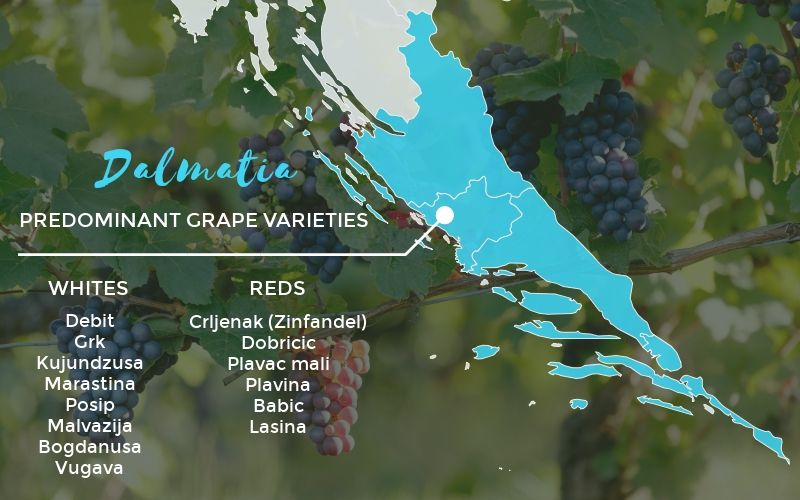
Dalmatia is today probably most known for being the homeland of the world-famous Zinfandel. Not so long ago, this robust red was in America considered to be native to California and recognized as a close relative to the Italian Primitivo, but as it turns out, both varieties are in fact genetically identical to an ancient Dalmatian variety called Kaštelanski crljenak (aka Tribidrag; Pribidrag), which was in 2002 confirmed by a DNA analysis.
But if they're all identical — you may ask — how can we know which variety is the ancestor? Well, the first written mention of the name Primitivo dates back to the year 1799, and Zinfandel was first mentioned in 1837, whereas the name Tribidrag dates back to the 15th century.
Etymologically, the word tribidrag is of Greek origin and roughly translates to "early maturation," just as the Italian name for this variety has its roots in Latin primativus, meaning the same — the first to ripen. On the other hand, the etymological origin of zinfandel remains a mystery.
It was also discovered that Crljenak and Dobričić were the parents of Plavac mali, one of Dalmatia's most widespread reds found mostly on the Pelješac peninsula and the islands of Brač, Hvar, Korčula, and Vis. This variety is particularly prized for its sturdiness and resistance to disease, so much so that the Dalmatians have an old saying that goes: "Praise every variety but plant Plavac mali."
Other notable Dalmatian red varieties include Plavina, Lasina, and Babić. The latter accounts for only about 1% of the production in Croatia, and the best site for this Dalmatian red is the UNESCO-listed Bucavac vineyard near Primošten.
As for the whites, Debit of Šibenik area is currently going through a renaissance and is gaining more and more recognition, but the king of Dalmatian white varieties is still Pošip, bar none. This is also the first Croatian variety with a protected geographical origin. Its natural habitat is the island of Korčula where Pošip originated through natural selection as a spontaneous crossbreed between two pre-domesticated vines, Bratkovina and Blatska zlatarica. Other notable Korčula varieties include Grk, Cetinka, and Maraština which is also widespread in other parts of Dalmatia.
Dubrovnik is most known for its Malvasia, though unlike the Istrian indigenous variety, Dubrovačka malvazija is in fact genetically identical to several Italian and Spanish varieties.
Stay tuned for more on Croatian wine regions by following TCN's dedicated gourmet page.
Željko Garmaz Nominated for Gourmand Award - Food and Wine Oscar!
Dalmatia – Wine Stories, written by Garmaz, has been nominated for the title of the best book in the world writing about European wines (except for French wines).


